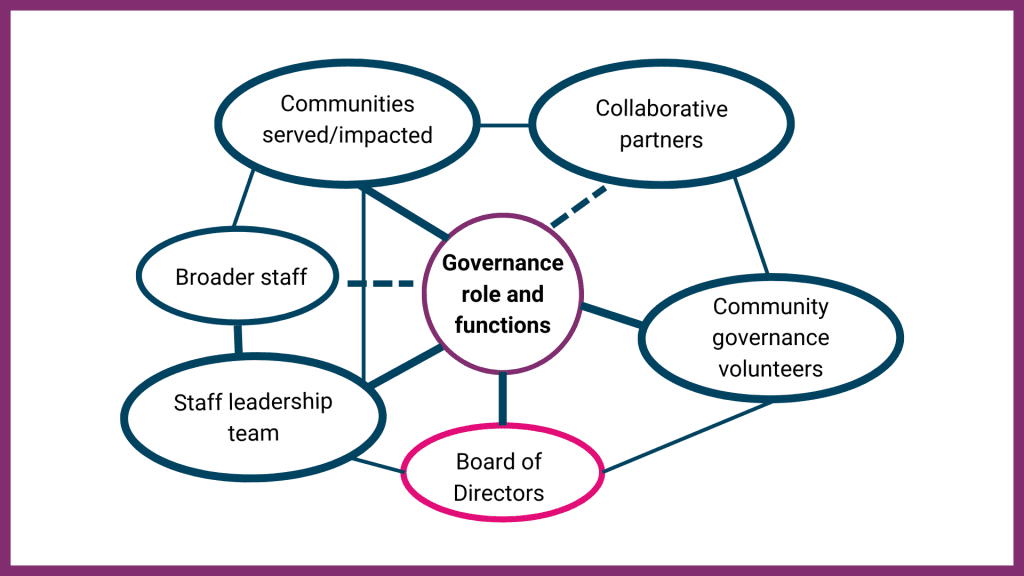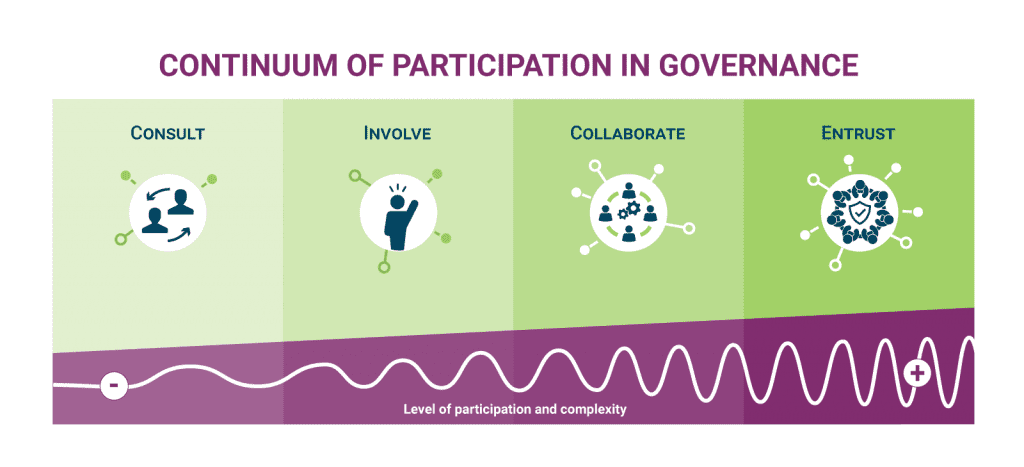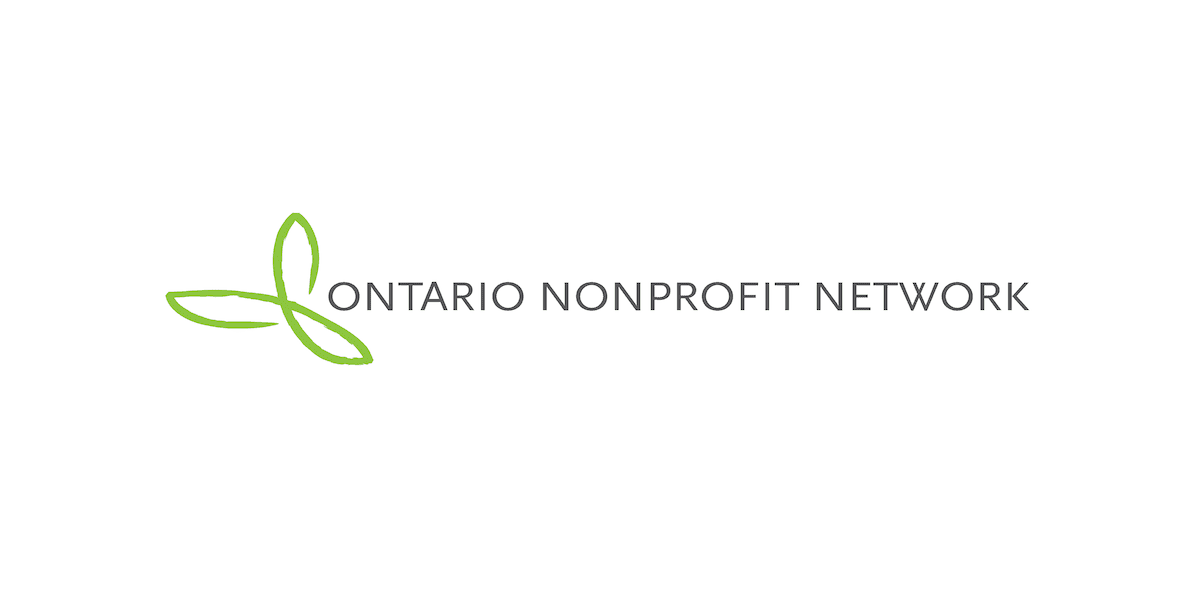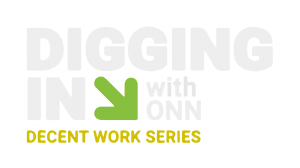
Blog
Governance as shared leadership for nonprofits
Governance as shared leadership: what is it? Why is it important, and how can nonprofits maximize its benefits while mitigating its challenges? Our final blog post in this three-part series aims to prompt conversations in your organization about sharing governance more broadly, beyond just getting stakeholder input, and to build your confidence that this kind of approach can be done effectively. To dive a little deeper into the topics touched on this blog, access the full video.
What is governance as shared leadership?
This is often how we understand governance decision-making:

The board is the locus of control. In fact, the words ‘the board’ and ‘governance’ are used interchangeably even though broader stakeholders like the staff leadership team, communities served, and volunteers often provide input into governance decisions. Their input may include everything from feedback to recommendations – but the board ultimately makes governance decisions.
It’s also interesting to note that in many organizations the board does operational work alongside its governance work. This adds to the confusion about roles of governance.
Now let’s look at a shared governance approach:

In this diagram, the centre point is the role governance plays in the organization – such as generating impacts – and the governance functions that must be performed. Everything else flows from these. The board still plays a critical role, but governance leadership is more broadly distributed, and decisions are made in a collaborative way. It feels more like interlocking nodes that form a system of governance.
Though these diagrams may oversimplify, they offer a good starting place for conversations. For example – does your governance approach look more like one of the diagrams or is it a hybrid? Why does it look that way?
Three reasons it’s critical to focus on shared governance leadership
1. Shared governance helps address the increased complexity of governance.
It’s tough for nonprofit boards to fulfill all the responsibilities of governance, which have become increasingly complex. While board members are generous with their volunteer time, it’s limited and the expectations placed on them are high. When organizations share responsibilities more broadly, it reduces the board’s burden, and leverages the talents, experience, skills, and knowledge of the organization’s full ecosystem..
2. Shared governance deepens equity and broadens decision-making.
There’s an urgency to deepen equity in decision-making, including widening the diversity of perspectives, and challenging some of the traditional ideas of who does governance work. Questioning who should and could share in decision-making, and making changes based on that, helps deepen equity.
3. Shared governance helps create more clarity.
Most organizations already share their governance – to some degree – but it’s not always done with clarity. For example, collaborations are growing, which means more governance decisions are made outside the single organization’s board room, like setting collective priorities. Yet many organizations don’t approach it with intentionality – like figuring out how to align conflicting directions — or manage complex risk and confusing accountabilities.
Clarity about shared governance can also be helpful for the partnership between the board and staff leadership. It’s often said that the board does governance and the staff leadership supports and implements it. But this simplistic distinction doesn’t begin to capture the complexity of the relationship. It also doesn’t acknowledge that staff leadership is actually doing a lot of governance work, not just supporting board decision-making.
Many organizations have governance committees, advisories and task groups that include non-board members. There’s often a Terms of Reference describing the intent and other expectations. But it is uncommon for underlying power dynamics to be addressed. For example, there may be clarity on paper about the authority these groups have to take action, but less about what power the board is prepared to give up.
The reality is that sharing governance responsibilities and decision-making has some challenges – along with benefits.
| BENEFITS | CHALLENGES |
|---|---|
| Generates better, richer decisions because there’s a diversity of perspectives. Governance is more equitable because more voices and views are incorporated into governance decision-making. | Demands more complex engagement and decision-making processes, which can require more time and resources. For example, it can be difficult to manage diverse opinions and agendas. |
| Generates stronger accountabilities by building higher levels of engagement, which energizes stakeholders and creates greater investment in the organization’s success. | Can weaken accountability because the board is letting go of power and authority to a wider network, which might put their fiduciary responsibilities at risk. It also requires the willingness and capacity of more people to assume responsibility for decisions. |
| Builds governance capacity by drawing on a wider pool of people — with the talents, skills, experience and knowledge required for more complex governance. | Demands an investment in recruitment strategies, training, coaching and mentoring. |

Maximizing benefits of shared leadership while mitigating challenges
We’ve identified three key strategies to maximize the benefits of shared governance leadership while mitigating the challenges:
- Recruit the leaders with the right skills, personal attributes, values and mindsets to make it work.
- Create an enabling culture.
- Adopt a purpose driven approach.
Dive deeper into each of these in our accompanying video.
It’s worth noting that trust is clearly at the heart of successful shared governance, which is hard to build and easy to lose. But if you adopt these three strategies, then trust is likely to follow. The diagram below shows an example of how your organization can adopt a purpose-driven approach. You’ll find it in the tool, Governance as shared leadership.

Get started on governance as shared leadership now
It’s more important than ever to explore how governance can be shared, taking advantage of the benefits and mitigating the challenges. Get started right now by taking one (or all!) of the following actions:
- Share this blog with your leadership and governance teams and have a conversation about what questions or insights spark for you.
- Check out the Board Essentials resource, and the accompanying tool Meeting the board essentials, to gain confidence you’re doing what you need to do before exploring sharing governance work.
- Learn more about shared decision-making in the resource, Shared Decision-Making for Nonprofit Governance.
- Dive deeper into governance work by exploring the Differentiating governance responsibilities and decisions resource, and then really dive in by experimenting with the Governance as shared leadership tool.
Governance as shared leadership isn’t just about tactics and engagement strategies – it’s about a mindset and way of working that’s premised on the belief that you can accomplish so much more through a collaborative, networked governance system.





